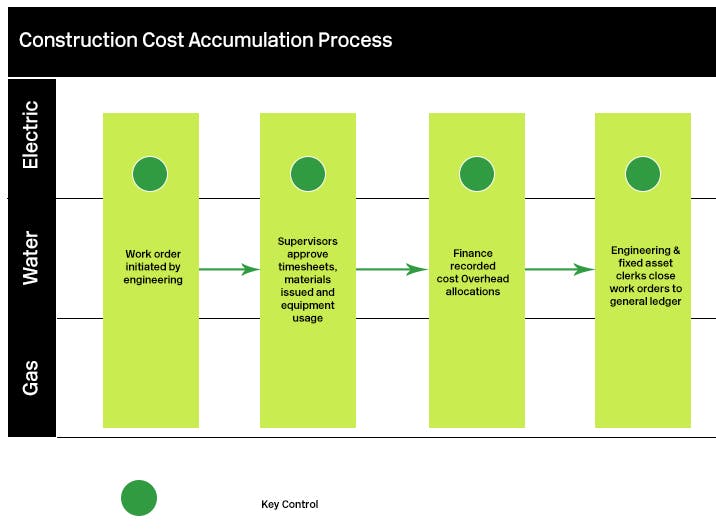
Designing operational efficiencies through process mapping
Identifying bottlenecks in business processes while maintaining good internal controls is an ongoing issue in every utility What do internal controls have to do with efficiencies you ask? Internal controls are nothing more than business processes. The definition of internal controls, i.e. “effectively allocating resources and protecting against fraud” is the definition of business processes. In other words, how do we get things done effectively in our organization while protecting our assets?
Identifying inefficient business processes
Inefficient business processes can sap resources in your utility. However, identifying bottlenecks and inefficiencies does not always have a clear path. Your organization may have decades of embedded processes in place and a culture resistant to change. The staff members, who regularly implement these processes, may know there are more efficient ways to do certain processes and can often provide the details on what needs changing. The act of change may be another matter due to institutional thought processes or obstacles.
Identifying inefficient processes and changing them are two separately activities. This article focuses on identification of inefficient processes. A subsequent article will discuss implementing change to increase process efficiencies.
Tools for changing business processes
There are two main approaches to changing business processes – Detailing the processes through a narrative or business process mapping. Each approach can be effective and both follow the same systematic work approach:
- Interview process owners for the process under review
- Document the detailed steps in the process through narrative or process mapping
- Test the process from beginning to end to determine process owners do what they said they do in the interview
- Analyze the process for inefficiencies or improvements
- Make recommendations for change
- Train process owners the new process
- Perform follow-up testing to determine the process works as designed
- Train process owners and repeat, as necessary, until the new process operates as desired
Although often the method used is a personal preference, some consider the narrative approach to be more cumbersome. Here is an example:
Case study – Analyzing the process for accumulating construction costs
A utility has observed its cost accumulation process slows the recording of fixed assets for completed projects in its general ledger and financial reporting. In a utility, fixed assets are not convertible into customer revenues until they are recorded in the financial records as completed and in service. Two approaches can identify bottlenecks in this process.
Approach A – Narrative
Analyst A likes to use the narrative approach to identify process inefficiencies. Analyst A interviews all process owners and develops a comprehensive multi-page narrative of the cost accumulation process. The narrative approach identifies all current process inefficiencies, and it is used to develop recommendations for efficiency improvements.
Due to the narrative’s level of detail, Analyst A must develop separate PowerPoint materials for presentations to process owners and other stakeholders on the current processes and how changes will lead to a more efficient process. There is also a steep learning curve for the participants as they must hear and process the words used to describe each area.
Approach B – Business process mapping
Analyst B prefers to use the business process mapping approach to identifying process inefficiencies. Analyst B interviews all process owners and develops a one-page business process map of the cost accumulation process as follows:

The process map identifies all current process inefficiencies and is used to develop recommendations for efficiency improvements. Analyst B uses this map for presentations to process owners and other stakeholders on the current processes. The discussion centers on how changes will lead to a more efficient process. The participants make real-time changes to the process map, as it is easy to move around the diagrams to determine how potential future changes in the process steps would impact the overall process.
While the sample case study favors the business process mapping approach, it supports the adage that a picture is worth a thousand words.
Documenting processes for future RPA application
Organizations are evaluating the use of robotic process automation (RPA) for application to financial and operational processes. RPA is dependent on detailed business process maps — the “bots” that run RPA applications use those maps step by step to analyze and execute a particular business process. Therefore, although Analyst A in the case study example prefers the narrative approach, the movement towards RPA will dictate that process analysts need to know how to map processes.
Making and using business process maps
Process mapping tools used to detail business processes range from a yellow legal pad to readily available software tools and apps. Business process improvement specialists with utility experience can offer insight into business process mapping as well as lend an independent, objective voice to your project. Process mapping can also be used by your utility’s internal audit function or other employees tasked with analyzing a process and making it more efficient.
For more information on this topic, or to learn how Baker Tilly power and utilities specialists can help, contact our team.
